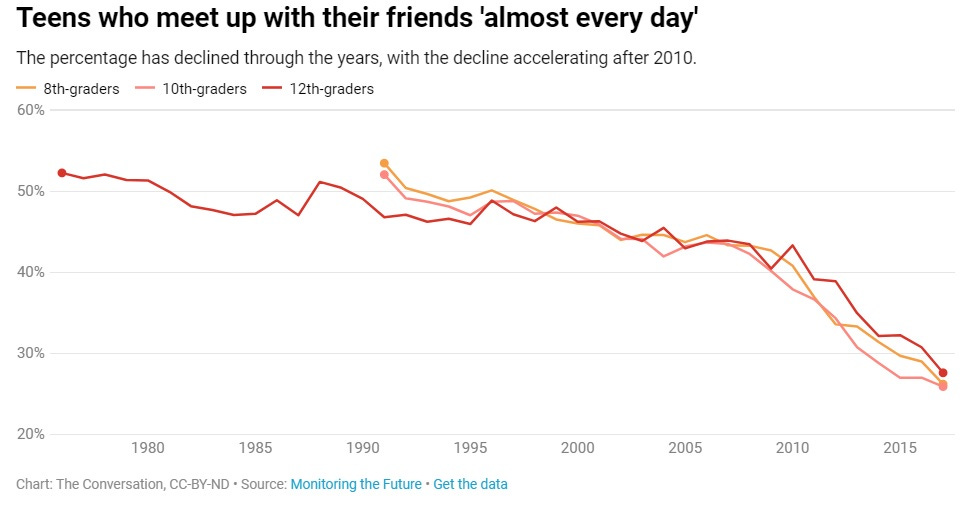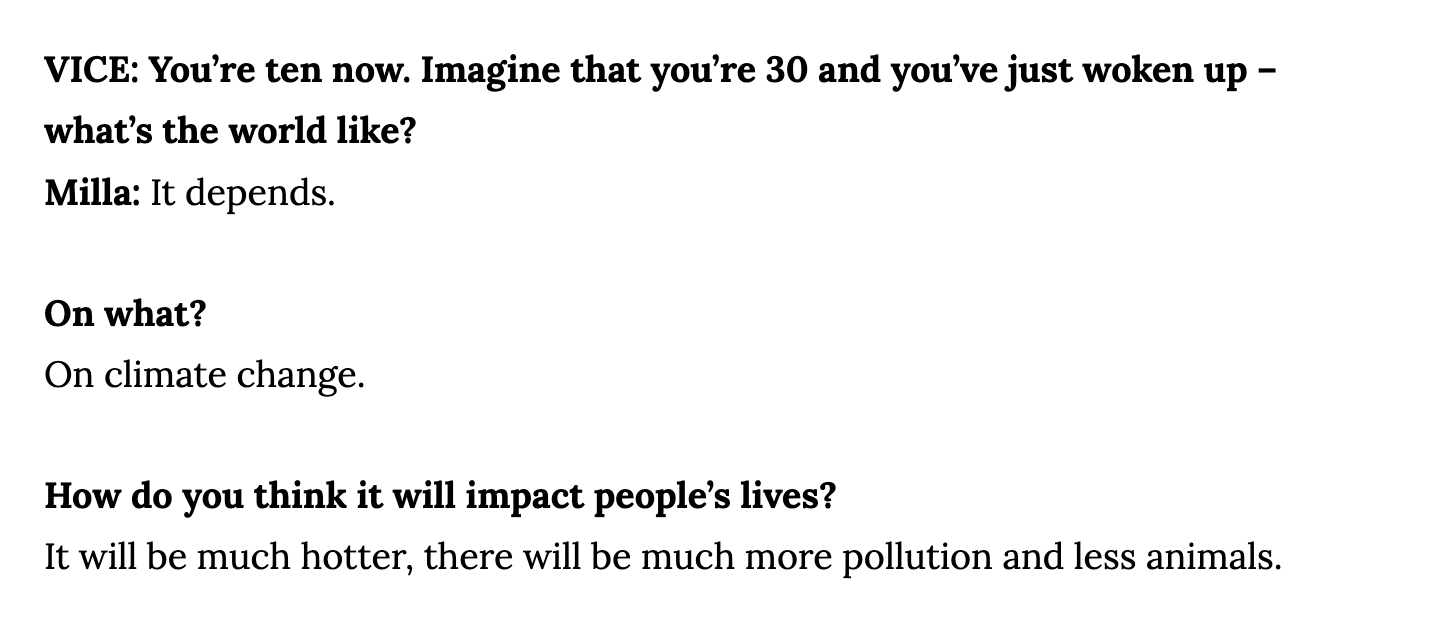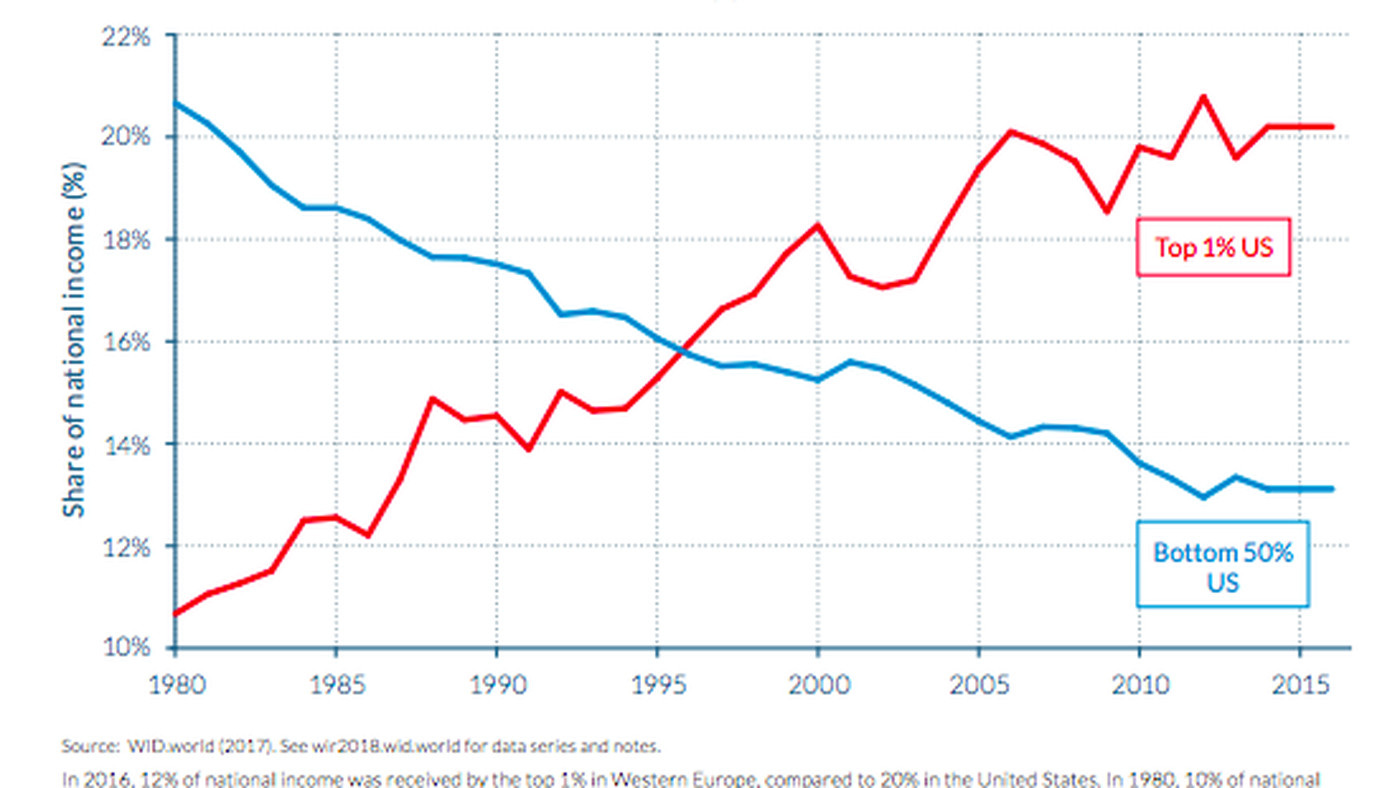America Has a Problem. Startups Are Trying to Fix It.
The Next Generation of Technology Companies Tackle Major Crises
Weekly writing about how technology shapes humanity and vice versa. If you haven’t subscribed, join 50,000 weekly readers by subscribing here:
America Has a Problem. Startups Are Trying to Fix It.
Beyoncé performed in New York over the weekend, showcasing her Renaissance album. One of its tracks—AMERICA HAS A PROBLEM—got me thinking. America has many problems. This country is in the midst of a series of crises: a climate crisis; a mental health crisis; a loneliness epidemic; an obesity epidemic; unprecedented income inequality. Some of these crises are global in nature (climate change, loneliness) while others are uniquely American (obesity and income inequality come to mind).
To visualize just a few of these crises:

The good news: startups are trying to innovate our way out of these crises. Capitalism—when well-designed, and with proper guardrails—is a powerful tool for incentivizing innovation; the scalability of internet and software products, meanwhile, offers the perfect catalyst for turbocharging that innovation.
I’ve written in the past about mission-driven startups, most recently in February’s How Impact Investing Applies to Venture Capital. From that piece:
What captivates me about technology is how it can better ignite and amplify impact. Entrepreneurship is the engine behind everything: innovation is the purest distillation of potential energy. And if entrepreneurship is the spark, technology is the kerosene that uses zero marginal costs to grow the fire.
This gets to the heart of why I love tech and startups. I often think of the quote, “The future is here—it’s just not evenly distributed.” Startups are addressing all of the crises above, and life should (soon) get better for all of us as a result.
My view is that the next iconic, generational companies will be those that solve real problems for real people. I like how Kirsten Green puts it when she says, “The game-changing companies are the life-changing companies.” Or how Marc Andreessen frames it as “It’s Time to Build,” recognizing that technology hasn’t yet reinvented major “impactful” categories like healthcare, education, and housing.
This chart may be the most frequently-cited chart in Digital Native:
Clearly, technology has a long ways to go in modernizing some of the largest and most important swaths of our economy.
This week’s piece dives into five key pillars of social impact—
Learning & Development
Health & Wellness
Climate & Sustainability
Community & Belonging
Job Creation
Within each, we’ll examine a few examples of innovation’s bleeding edge. Given the excitement around AI right now—and its potential to reinvent every industry—I’ve especially focused on early-stage companies using AI to address America’s crises.
Let’s dive in 👇
Learning & Development
COVID had an alarming impact on student test scores. A national survey of 9-year-olds showed a steep drop-off in math & reading scores:
The good news is that COVID also highlighted major fissures in our education system. During the pandemic, it became critical that schools adopt new technologies that help students learn. But the bureaucracy and lethargy in the school system prevented quick adoption and adaptation. People are now waking up to that fact.
That same bureaucracy and lethargy have made EdTech a tough category for venture capital. It’s difficult to achieve the escape velocity growth required to support a venture-scale outcome when you’re selling into schools and school districts—budgets are thin; sales cycles are long; and decision makers are inconsistent (is it the teacher? the principal? the superintendent? all three?).
As a result, many of the education successes of the past decade have been direct-to-learner (e.g., Duolingo) or have used clever workaround business models (Guild, for instance, gets companies like Walmart and Chipotle to offer education-as-a-benefit by reducing costly worker attrition). There’s reason to hope that EdTech will now inflect, as schools and teachers have learned to become nimbler at adopting new technologies. (I dove deeper into what’s happening in education in April’s From Chalkboards to Chatbots: Our Long-Awaited Education Revolution.)
One area I’m especially interested in: how AI will change education.
We’ve already seen both students and teachers lean heavily on ChatGPT. And now, education-specific AI products are emerging. Class Companion, for instance, is an AI companion starting with Social Studies. Students can interact with the AI on learning exercises:
One area I’m focused on for AI’s emerging application layer is the concept of the copilot. We’re all getting copilots that make our lives easier. Developers can use GitHub Copilot to code better and faster; lawyers can use Harvey to amplify legal work; copywriters can use Jasper to be better at content generation.
Everyone—lawyers, doctors, writers—gets a copilot.
Teachers and students are no exception. In addition to offering students a copilot for learning, Class Companion offers teachers a copilot for evaluating assignments. The product promises to save teachers 10+ hours per week, unlocking valuable time for lesson planning, small group discussion, and individual instruction.
Education hasn’t been disrupted in a long time. That might be due for a change, and vertically-focused AI copilots are an interesting place to start.
Health & Wellness
Above, I wrote that the obesity epidemic is a uniquely American crisis. This chart bears that out, comparing obesity rates in Europe and in the US:
Yikes.
The good news is that technology is making headwinds. GLP-1 agonists, known colloquially as Ozempic and Wegovy (Ozempic is the name of the drug approved for Type 2 diabetes, while Wegovy is the name of the drug approved for weight loss), are becoming a certified phenomenon.
The Economist estimates that by 2031, the market for GLP-1 drugs will be over $150B. For perspective, that’s on par with the market size of all the drugs used to treat cancer ($185B in 2021).
We’re already seeing the impact on the startup landscape. In New York, Ro’s billboard ads are ubiquitous. (My good friend Zach Reitano, Ro’s co-founder and CEO, has an excellent deep-dive on Ozempic and its many critiques—check it out here.)
I expect there will be various opportunities for enterprising entrepreneurs—the drug companies will win, sure, but there will also be ecosystems of “Ozempic influencers” and “Wegovy coaches” and online managed marketplaces for access to weight loss drugs. This may be one way we innovate ourselves out of the obesity epidemic, though the solutions to that crisis are much more complicated and nuanced (January’s How Startups Are Combatting America's Obesity Epidemic digs into more detail, like our food supply and food deserts.)
Ozempic’s competition for “Word of the Year” is ChatGPT. I’m also interested in how AI is seeping into healthcare.
There are some creative ways that startups are applying AI to our economy’s largest industry (18% of GDP) and our nation’s biggest employment sector (22M workers). One example is Alife, which brings AI to in vitro fertilization (IVF). My brother is an OB/GYN, so what Alife is building is of particular interest to me.
Essentially, Alife gives practitioners AI-powered tools to improve their decision-making on decisions like embryo selection (selecting which eggs to implant) and ovarian stimulation (dosing medication). Alife benefits from data network effects: the more patients the model trains on, the better its recommendations become and the more potent its data moat. (This is why vertical AI applications are so compelling.)
In some ways, Alife becomes a copilot for your OB/GYN during critical human decisions.
A more clear-cut example of the copilot thesis is what’s happening with medical scribes. In the past, a scribe has been a human who takes notes in real-time during a physician-patient interaction.
Now, we’re seeing startups build AI scribes for physicians. Ambience, for instance, sits on top of a clinician’s existing workflow and automatically ingests data and context from the electronic medical records. The clinician can speak to patients as she normally would, and Ambience listens in the background, then creates an AI-generated draft into the EMR within seconds.
Just as teachers are getting AI copilots in the examples above, doctors are getting AI copilots that will make them more effective at their work. The hope is that bringing an archaic industry like healthcare into the 21st century will improve patient experience and reduce costs.
Climate & Sustainability
The chart earlier showed that our planet just had its hottest month on record. Ocean temperatures in Florida last week hit 101.1 degrees Fahrenheit—essentially turning the sea into a giant hot tub.
Vice put out an interesting piece in which they interviewed kids about the future. Many of the kids were (rightly) worried about the future of our planet. Asked what life will be like when he’s 30, 10-year-old Leonardo said: “Well, I heard that if we don’t save the earth in a few years, it’ll be too late. So when I’m 30, I don’t think I’ll be here anymore.” Talk about a depressing thing to hear from a 10-year-old.
Milla, also 10, shared the same concerns:
9-year-old Jeanne said she’s afraid “that the world will die.”
Many in the tech world take solace in the fact that humans have historically innovated ourselves out of crises. Shouldn’t be able to do the same with this crisis? Last week, I wrote about how climate tech funding is booming—that’s the good news. But we still need to do more, and fast.

There are some fascinating startups out there; I’m consistently amazed by the technologies and business models addressing the climate crisis. To give one example:
One of my favorite statistics is that there are more trees on Earth than stars in the Milky Way Galaxy. (This stat originally comes from a study in Nature that estimated 3 trillion trees on our planet compared to the 100-400 billion stars in our galaxy.) And trees are a potent source of decarbonization, absorbing about one gigaton of CO2 each year. One of the keys to fighting climate change is protecting our forests (and planting more trees!).
Many landowners have forests, but it’s hard for them to understand the economic value of that forest. In the burgeoning carbon credit market, forest owners can receive compensation for maintaining and growing their forests. (Instead of selling their forest to the timber market, they might instead earn income for simply not cutting down their trees.) One problem in this market has been accurate forest measurement.
But today, with satellites, it’s becoming possible to use space-based imagery to measure forests. A startup called NCX does exactly that, creating a Basemap forest dataset that underpins the Natural Capital Exchange (what NCX stands for). In other words, NCX can tell forest-owners what their trees are worth.
This enables a new market. On one side are the landowners; on the other are companies and governments that can become purchasers. Measurement is the key foundation, provided by NCX, offering a linchpin for the forest economy.
This is just one example of creative new companies that are addressing the climate crisis. Many more are in the works, and climate tech should become one of the fastest-growing areas of tech this decade.
Community & Belonging
One reason I’ve always loved tech is how it connects people in new ways. One of my favorite quotes about the internet—and one I’ve shared often in Digital Native—comes from Patreon’s Jack Conte: “You may have grown up in a small town, where you were the only person out of 1,000 people with a specific interest. But there are 4.5 billion people on the internet, meaning that there are 4.5 million people who share your interest. Online, no niche is too niche.”
This is also true for marginalized communities—many queer people, for instance, find belonging online before they find belonging offline. I like to use the example of a Chinese gay dating app called Blued. When Blued went public in summer 2021, its founder, Baoli Ma, was unusually personal in the company’s SEC filing:
I was laden with agonizing loneliness, helplessness, and fear of the future during my adolescence. I used to think that I was the only person in the world attracted to people of the same gender and that I was sick and needed treatment. That was why, when I found out on the Internet that there were other people like me, and that homosexuality was not an illness or disorder, I felt a tremendous sense of relief and excitement. After all, I’m not alone in this world. After all, we are not sick. After all, love is gender blind.
To me, herein lies the power of the Internet—it empowers us to elevate ourselves, and to bring warmth to others across all corners of the world living in loneliness, helplessness and fear because of their sexual orientation.
The internet may be a causal factor in our loneliness and mental health epidemics, but it’s also an important solution.

We’re seeing AI become a copilot for companionship and friendship. This comes in the form of chat apps like Chai (a portmanteau of “chat” and “AI”) and in mental health bots like Woebot Health. For many lonely people—and 60% of Americans report feeling lonely on a regular basis—these apps can be a salve. Of course, AI copilots shouldn’t be replacements for true companionship or offline connection, but they can help.
We’re also seeing clever new ways that AI can facilitate connection.
Speaking of the queer community, one of the most important non-profits in the LGBTQ+ world is The Trevor Project. The Trevor Project focuses on suicide prevention by operating a toll-free number where LGBTQ+ youth can speak to trained counselors. Two former employees, Sam Dorison and John Callery, recently left The Trevor Project to launch a company that offers AI-powered tools to train, develop, and support such counselors.
ReflexAI is an interesting example of applied AI to facilitate better connection. The product builds on LLMs to more quickly and more effectively train and support workers in high-stake call centers, which field more than 250M phone calls a year. This is a non-obvious use case for AI, but one that should yield important solutions to increased loneliness and deteriorating mental health.
Job Creation
When I talk about job creation as a startup theme, I’m typically talking about digitally-native jobs. These are the jobs uniquely enabled by an internet platform—jobs like Roblox Developer, Flagship Merchant, Nourish Dietitian. Each of those companies is, in some way, a marketplace connecting a person supplying a good or service (a game on Roblox, a curation of products on Flagship, dietary advice on Nourish) with a person consuming that good or service.

These types of businesses are often among the largest technology success stories. And they typically create ecosystems of work that far outpace the actual number of workers they employ: as I wrote in last fall’s The Rise of the Digitally-Native Job, 9.5M sellers earn income on Amazon, compared to Amazon’s 1.1M workers, while Etsy has 7.5M active sellers from 234 countries but only 2,800 employees.
New internet-native jobs are particularly important in an economy with worsening income inequality. If traditional careers fail workers with stagnant wages, can new online jobs offer more flexibility, autonomy, and economic opportunity?
“Job Creation” can also encompass the companies that are building blocks for new businesses and new forms of work. In the last era of tech, this was Stripe and Twilio. Now, an example would be Langchain, which lets you build applications with Large Language Models (LLMs). As AI’s application layer matures, we need companies like Langchain that abstract away the complexity of building applications.

Last week, Meta announced that it was making its large language model, Llama 2, openly available for free. In contrast to GPT-4, which can be licensed from OpenAI, developers can build on top of Llama 2. This is another important step to building with generative AI—and opening floodgates to new kinds of companies and new forms of work.
New tech eras often usher in new jobs: in the past couple decades, we’ve seen job titles like Cybersecurity Analyst, Social Media Manager, and SEO Consultant emerge. What’s next? A new set of jobs are set to be created, built on top of the continued growth of the internet and the nascent wave of AI.
Final Thoughts
Despite the crises above, the world is getting better. (The book Factfulness does a good job explaining how, zoomed out, life is improving for our species.) But technology is also at a tipping point where it has the potential to accelerate the speed of improvement. My hope is that the next decade brings a new generation of entrepreneurs building real solutions to the very-real problems outlined above.
I’d be curious what startups I’ve overlooked, or what other innovative solutions are tackling problems like mental health, climate change, and loneliness. Shoot me a note with any I’ve missed 📬
Until next week 👋
Thanks for reading! Subscribe here to receive Digital Native in your inbox each week:

















